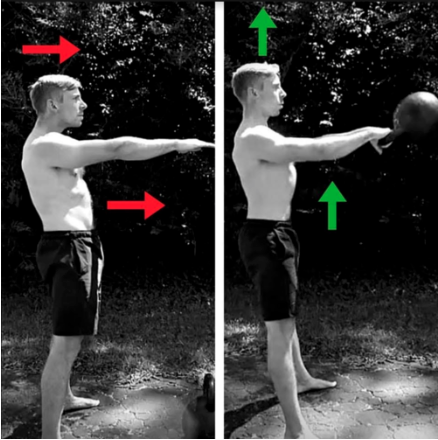Avoid These Mistakes To Avoid Injury

Cleaning up the Swing and the Get-Up
The kettlebell is a powerful tool in the hands of a knowledgeable coach and capable trainee. From rehab to prehab to performance, the mighty kettlebell has a place in nearly any training program. But, like any other tool, it can do more harm than good without a critical approach and proper form. Here are a couple of the biggest bang-for-your-buck moves and how to correct the most common fault for each.
The Swing
“The swing is a fat-burning athlete builder.” - Dan John
Indeed, the kettlebell swing can be utilized by just about any person with a good hip hinge pattern. The swing develops explosive strength through the hips and packs a huge metabolic punch without the impact of plyometrics or sprints.
As an exercise in pure hip extension, I’ve even used it to great success with powerlifters looking to improve their deadlifts and squats. But, the swing can quickly degrade into a hot mess without attention to a few crucial details.

After getting the basic mechanics of the swing down, the most common issues typically come from extraneous movement throughout the body. This often looks like a hyperextended low back from “over swinging” the hips past 90 degrees and allowing the head to jut forward at the top of the move.
These positions rob you of performance and power and risk spine, neck, and shoulder health. This common fault typically stems from placing too much focus on the weight itself and not enough focus on the internal cues of how a strong hip extension should feel.
To groove a better lockout, it may be helpful to practice the hardstyle plank.
Get into a forearms-down plank and focus on “zipping up” every muscle in your body from the clavicle down. The quads, glutes, abs, and lats are particularly engaged as they stabilize the spine and prevent undue motion. The neck and face stay relaxed. This is what the top of every swing should look and feel like.
After a few hardstyle plank holds of 10-15 seconds (we’re going for maximal engagement here, not endurance), go back to the swing and think - maximal contraction of the posterior chain, stand at attention, and keep a high crown.
These cues, though subtle, will ensure the swing strengthens, not stresses the low back and allows for safe power production over dozens and hundreds of reps.
The Turkish Get-Up
The TGU is a proving ground for shoulder stability and strength. The TGU can also be a great environment to practice breathing, T-spine mobility, core engagement, and rolling patterns. Indeed, much like the swing, it’s a catch-all move that provides numerous benefits. But, that’s all for naught if the brain is receiving distress signals from a “broken” wrist.
With all the moving parts going on in a get-up, it can be easy to forget the importance of how you’re actually in contact with the bell.
The proper handling of the kettlebell means the handle is placed at the base of the palm rather than across the base of the fingers. Because of the offset center of gravity, the bell cannot be grasped like a dumbbell or barbell. Doing so will end up pulling the the hand backwards, creating wrist extension and a dangerous, uncontrollable position.
The bell placed at the heel of the hand allows the wrist to remain straight, even if the fingers were to open. This will not only prevent wrist and hand pain, but also keep the bell centered, allowing for better control through all steps of the get-up.

Bonus tip: Many people find that orienting the grip toward the pinky corner of the bell provides more stability and a better grasp of the handle.
There you have it - two exercises that can cover most, if not all of the major goals in training. In fact, Pavel Tsatsouline's book and training program “Simple & Sinister” is written around the 1-arm swing and TGU only!
Keep an eye out for these common mistakes in your own or your client's technique and take full advantage of what the kettlebell has to offer!
ABOUT THE AUTHOR
Zack Henderson, SFG II, SFL, SFB, FMS enjoys coaching people of all skill levels to become stronger than ever.
His students include powerlifters, kettlebell enthusiasts, and the everyday athlete who wants to look and feel better.
Zack’s blog and podcast can be found here. He trains locally in Nashville, TN.

